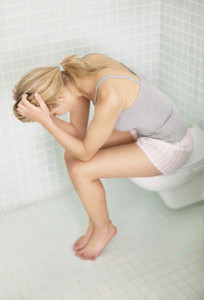Do you have irregular periods, acne, hard-to-shift weight or hair growth in all the wrong places? Maybe you’ve been trying to conceive yet the pregnancy test is negative month after month. You may have PCOS – Polycystic Ovarian Syndrome.
What is PCOS?
PCOS is a syndrome that affects women’s hormones, ovulation and menstrual regularity (periods). It is not known what causes PCOS but the key features are excess levels of male-type hormones known as androgens (including testosterone), irregular or absent periods and the appearance of many small cysts on the ovaries when imaged via ultrasound. The cysts are not dangerous or painful and shouldn’t be confused with other sorts of ovarian cysts, which may cause pain, nausea and bloating. In PCOS, the cysts actually occur when a developing egg is not released. This lack of ovulation may lead to difficulty conceiving.
What are the signs and symptoms of PCOS?
Common signs and symptoms of PCOS include:
- irregular periods (your periods are longer or shorter than 25-35 days apart)
- absent periods (you haven’t had a period for 3 months or more)
- 12 or more cysts on each ovary when viewed on an ultrasound
- acne
- hirsutism – excess facial or body hair growth (e.g. on your chin, chest, back, belly or upper arms)
- scalp hair loss or thinning
- oily skin and hair
- dandruff
- hard-to-shift weight
- sugar cravings
- dark patches of softer skin in body folds such as the neck, underarms and groin
- anxiety
- PMS
- low mood
- difficulty with fertility (trying to conceive for 12 months or more without success)
Do I have PCOS?
It is difficult to know if you have PCOS because there are many signs and symptoms and you don’t have to have all of them to be diagnosed with the syndrome.
PCOS was named so because many women with the syndrome have lots of small cysts on their ovaries when viewed by ultrasound. But, confusingly, you don’t even have to have the cysts to be diagnosed with the syndrome! Two out of three of the following criteria are enough:
- signs and symptoms of excess male hormones (including high levels in blood results or physical symptoms like acne or excess hair growth)
- irregular or absent periods
- polycystic ovaries on ultrasound
PCOS will present in different ways from woman to woman depending on which symptoms she is most susceptible to. Furthermore, some cases will be more severe and others may only have mild symptoms.
What should I do if I have symptoms of PCOS?
If you are experiencing any of the above symptoms, follow this simple action plan:
- Begin tracking your period in a smartphone app such as iPeriod or similar. It’s important to know just how often you do get a period so that you can give your healthcare practitioner accurate information.
- See your healthcare practitioner to have your hormones tested and find out exactly what’s going on. No point guessing when you can get an accurate account.
- Have a pelvic ultrasound to see if you have polycystic ovaries.
If you are diagnosed with PCOS, you needn’t despair. The good news is, the first line of treatment for PCOS is diet and lifestyle changes – something that you have a great deal of control over. There are also many herbal and nutritional medicines that can help improve the symptoms of PCOS, restore regular periods, clear skin and increase chances of conception. I’ll be talking about PCOS causes and treatments in future articles.
You may also be interested in
- Information about our Fertility Consultant, Nurse, Midwife, Lecturer & Author (28 yrs experience)
- What is PCOS?
- What Causes PCOS?
- PCOS Diet
- 7 Ways to Boost Fertility Naturally
- Get Your Diet Right For Fertility
- Top 5 Tips for Avoiding Chemicals That Harm Fertility
- What’s your 5 Day Fertile Window?



